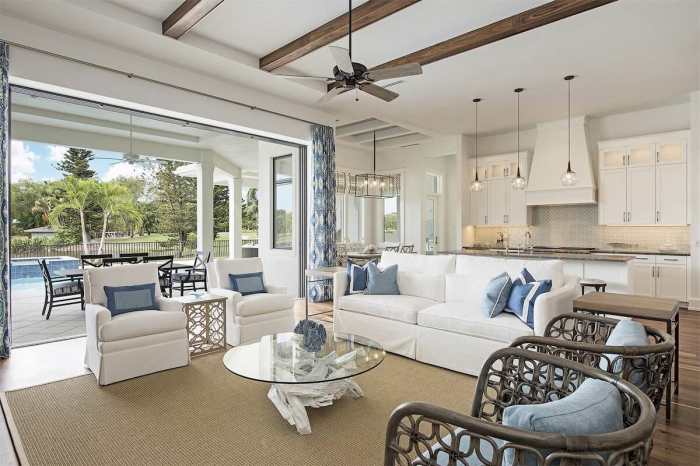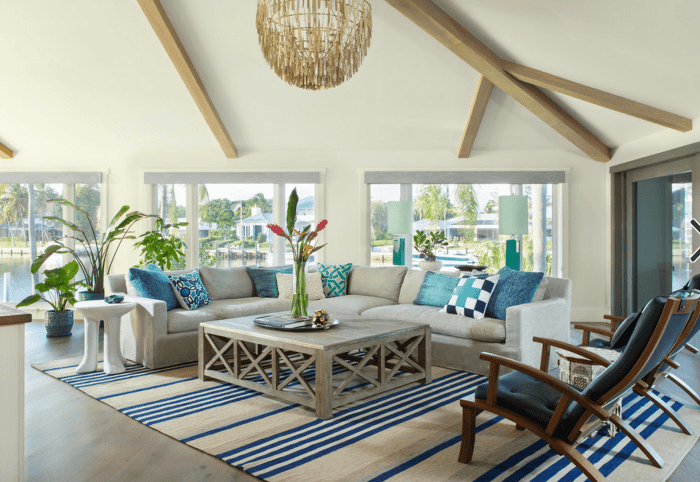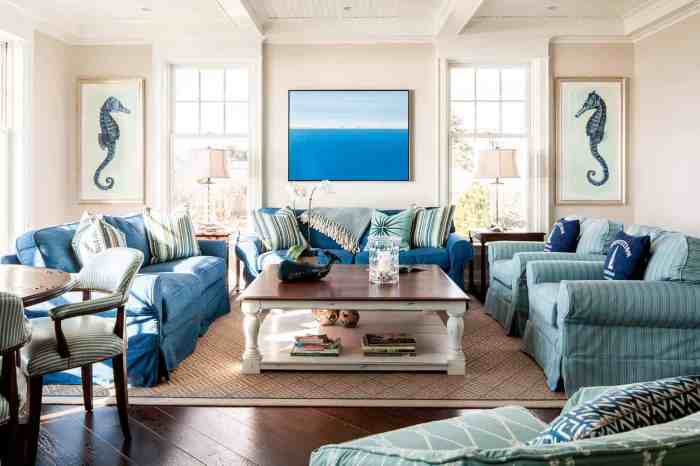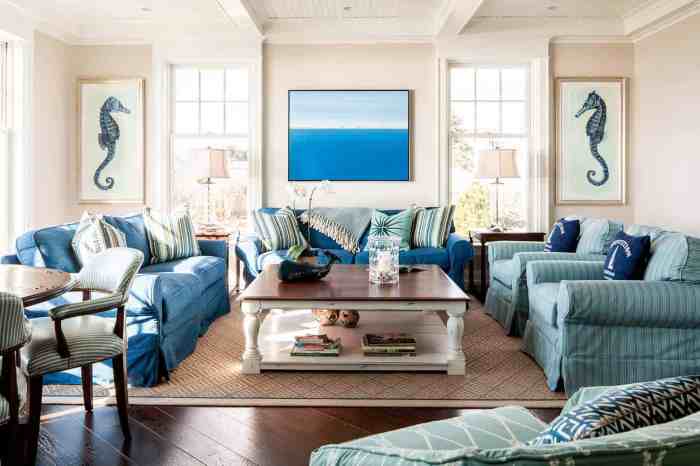Beach house coastal interior design is a style that embraces the serenity and beauty of the seaside, transforming homes into tranquil havens. This design aesthetic seamlessly blends natural elements with a relaxed and inviting atmosphere, creating spaces that evoke a sense of calm and rejuvenation.
From the calming color palettes to the use of natural materials, every element in coastal design is carefully chosen to create a harmonious and inviting space. The goal is to bring the essence of the coast indoors, fostering a connection with nature and promoting a sense of peace and well-being.
The Essence of Coastal Design

Coastal design is a style that embraces the relaxed and serene atmosphere of the seaside, bringing the tranquility of the ocean indoors. It’s all about creating a space that feels fresh, airy, and connected to nature.
Color Palettes
Coastal design often utilizes a calming and refreshing color palette that reflects the natural beauty of the ocean and its surroundings. The dominant colors are typically soft blues, greens, and whites, reminiscent of the sky, water, and sand. These hues create a sense of spaciousness and tranquility, bringing the outdoors in.
- Soft blues, ranging from pale sky blues to deep ocean blues, evoke a sense of calm and serenity.
- Greens, inspired by seagrass, driftwood, and coastal vegetation, add a touch of natural warmth and vibrancy.
- Whites, representing the sandy beaches and foamy waves, create a bright and airy atmosphere.
Textures and Materials
Coastal design emphasizes natural textures and materials that evoke a sense of the seaside. These elements create a welcoming and relaxed atmosphere, reflecting the organic beauty of the coast.
Beach house coastal interior design often embraces natural elements, light colors, and a sense of relaxed living. This style seamlessly blends with many of the 2024 interior design trends highlighted in 2024 interior design trends house beautiful , including the use of sustainable materials, biophilic design, and a focus on creating calming and functional spaces.
These trends allow you to bring the outdoors in and create a tranquil haven in your beach house.
- Natural fibers, such as linen, cotton, and jute, are commonly used for upholstery, rugs, and curtains, adding a touch of rustic charm.
- Wood, especially weathered driftwood and reclaimed wood, brings a sense of coastal history and authenticity.
- Stone, such as sandstone and granite, adds a touch of rugged elegance, reminiscent of coastal cliffs and rocks.
Incorporating Natural Elements
Coastal design often incorporates natural elements that evoke the beauty and essence of the seaside. These elements add a touch of whimsy and authenticity, bringing the outdoors in.
- Driftwood, found washed ashore by the ocean, can be used as decorative accents, furniture pieces, or even wall art.
- Shells, collected from the beach, can be displayed in bowls, jars, or used as decorative elements in various arrangements.
- Coral, a natural wonder of the ocean, can be incorporated as decorative accents, adding a touch of color and texture.
Color Palette and Mood
The color palette of a beach house coastal interior design plays a crucial role in shaping the overall mood and atmosphere of the space. Coastal colors evoke a sense of tranquility, freshness, and relaxation, reflecting the calming nature of the ocean and the vibrant hues of the surrounding landscape.
The Psychology of Color, Beach house coastal interior design
Color psychology explores the impact of different colors on human emotions, behavior, and perceptions. In coastal design, color choices are carefully considered to create a serene and inviting ambiance.
- Blue:As the dominant color of the ocean, blue evokes feelings of peace, calmness, and serenity. It has a calming effect on the mind and body, promoting relaxation and a sense of tranquility.
- Green:Inspired by lush coastal vegetation, green symbolizes nature, growth, and vitality. It brings a sense of freshness and vibrancy to the space, creating a connection to the outdoors.
- White:White represents purity, simplicity, and spaciousness. It reflects light, making rooms feel larger and brighter. White is often used as a neutral backdrop to highlight other colors and textures.
- Beige and Cream:These warm neutrals create a sense of comfort and warmth. They complement the natural tones of wood and stone, creating a cohesive and inviting atmosphere.
- Sand and Coral:These warm hues evoke the colors of the beach and sunset, adding a touch of vibrancy and warmth to the space. They can be used as accent colors to create focal points and add visual interest.
Textiles and Fabrics
Textiles play a crucial role in creating a coastal atmosphere. They contribute to the overall feel of a space, influencing its texture, color, and overall aesthetic. Fabrics, with their inherent textures and patterns, provide the perfect medium for bringing the essence of the coast indoors.
Coastal Fabrics
The choice of fabrics in a coastal interior design scheme is vital. They add warmth, comfort, and visual interest. Natural fibers are particularly well-suited for coastal interiors, reflecting the relaxed and organic feel of the seaside.
- Linen: Linen is a popular choice for coastal interiors due to its natural texture and breathable properties. It adds a relaxed and airy feel to a space, perfect for capturing the essence of a seaside breeze. Linen drapes beautifully and can be used for curtains, upholstery, and bedding.
- Cotton: Cotton is another natural fiber that is widely used in coastal interiors. It is soft, comfortable, and easy to care for. Cotton is ideal for creating a relaxed and inviting atmosphere, and it comes in a wide range of colors and patterns.
- Burlap: Burlap adds a rustic and earthy touch to coastal interiors. Its rough texture and natural color evoke a sense of the outdoors. Burlap can be used for curtains, rugs, and throw pillows, adding a touch of texture and warmth.
Coastal-Inspired Prints
Coastal-inspired prints are an excellent way to infuse a space with the essence of the sea. These prints can be incorporated into various textiles, adding a touch of whimsy and personality to the design.
- Stripes: Stripes are a classic coastal print, reminiscent of nautical flags and seaside attire. They add a sense of movement and dynamism to a space. Stripes can be incorporated into curtains, bedding, and upholstery, creating a visually stimulating effect.
- Nautical Motifs: Nautical motifs, such as anchors, ships, and seashells, are a popular choice for coastal interiors. These motifs add a touch of whimsy and nostalgia, evoking the spirit of adventure and exploration. They can be incorporated into throw pillows, rugs, and artwork.
- Floral Patterns: Floral patterns, particularly those featuring beach flowers like sea lavender and beach roses, add a touch of softness and femininity to coastal interiors. These patterns can be incorporated into curtains, bedding, and upholstery, creating a sense of tranquility and relaxation.
Beach house coastal interior design often evokes a sense of relaxation and connection to nature. From light and airy color palettes to natural textures, the goal is to create a space that feels both welcoming and stylish. If you’re designing a 1700 sq ft house, you can incorporate these principles by using a combination of materials like wood, stone, and wicker.
1700 sq ft house interior design can help you create a space that feels spacious and airy, even in a smaller footprint. Whether it’s a cozy beach cottage or a sprawling waterfront home, the right design choices can transform your beach house into a true sanctuary.
Lighting and Natural Elements
Coastal interiors are all about embracing the serenity and beauty of the ocean. Natural light plays a crucial role in achieving this, bringing in a sense of space and tranquility. To truly capture the essence of coastal living, we need to consider how to maximize the use of natural light and incorporate natural elements into the lighting scheme.
Maximizing Natural Light
Natural light is the foundation of a bright and airy coastal interior. Maximizing its impact involves strategic window placement and the use of light-reflecting materials.
- Large windows: Maximize natural light by installing large windows that allow ample sunlight to flood the space. Consider floor-to-ceiling windows or expansive bay windows for a dramatic effect.
- Light-colored walls and furniture: Choose light colors for walls, furniture, and fabrics to reflect light and create a sense of spaciousness. Opt for white, cream, light blues, and greens.
- Mirrors: Strategically placed mirrors can amplify natural light and create a sense of depth. Place mirrors opposite windows to reflect sunlight and brighten dark corners.
Incorporating Natural Elements
Coastal interiors often incorporate natural elements like shells, driftwood, and sea glass to create a sense of the ocean’s presence. These elements can be seamlessly integrated into lighting fixtures and decorative accents.
- Shell chandeliers: Shell chandeliers add a touch of whimsy and coastal charm. They can be made from various types of shells, from delicate sea shells to larger oyster shells, creating a unique and eye-catching focal point.
- Driftwood lamps: Driftwood, with its natural texture and unique shapes, can be transformed into rustic and charming lamps. The weathered wood adds a touch of natural beauty and complements the coastal theme.
- Sea glass accents: Sea glass, with its smooth, frosted texture and vibrant colors, can be used to create decorative accents for lamps or sconces. The iridescent quality of sea glass adds a touch of sparkle and captures the essence of the ocean.
Designing a Coastal Lighting Scheme
A well-designed lighting scheme enhances the natural beauty of the space and creates a warm and inviting ambiance. Here are some key considerations for a coastal lighting scheme:
- Layered lighting: Combine different types of lighting, such as ambient, task, and accent lighting, to create a balanced and functional lighting scheme. Ambient lighting provides overall illumination, task lighting focuses on specific areas, and accent lighting highlights features.
- Warm white light: Choose warm white bulbs for a soft and inviting glow. Avoid harsh white light, which can create an artificial and sterile feel.
- Dimmers: Install dimmers to adjust the brightness of lights according to the mood and time of day. Dimmed lights create a cozy and intimate atmosphere, while brighter lights are ideal for daytime activities.
Creating a Sense of Flow

The beauty of a beach house lies in its ability to seamlessly blend the indoor and outdoor spaces, blurring the lines between the home and its natural surroundings. This creates a feeling of openness, relaxation, and a constant connection to the calming energy of the sea.
Connecting Indoor and Outdoor Spaces
The key to achieving this harmonious flow is to design the house in a way that allows for a natural transition between the interior and exterior. This can be accomplished by utilizing large windows, French doors, and open floor plans, which invite the outdoors in and extend the living space beyond the walls of the house.
Large Windows and French Doors
Large windows and French doors serve as portals to the outside world, framing breathtaking views of the ocean, sandy beaches, or lush gardens. These architectural elements allow natural light to flood the interior, creating a bright and airy ambiance that feels welcoming and inviting.
“Imagine waking up to the sunrise filtering through expansive windows, casting warm hues across your living room, or enjoying a leisurely dinner with the gentle sea breeze wafting through French doors that open onto a charming patio.”
Open Floor Plans
Open floor plans break down barriers between rooms, creating a sense of spaciousness and fluidity. This design approach allows for easy movement between the living areas and the outdoor spaces, making the transition from inside to outside effortless and natural.
Outdoor Furniture and Accessories
Extending the living space into the garden or patio with outdoor furniture and accessories creates a cohesive and inviting atmosphere. Comfortable seating areas, dining tables, and even outdoor kitchens can be incorporated to create functional and stylish outdoor living spaces.
“Imagine a cozy conversation pit with plush outdoor cushions, perfect for stargazing on warm evenings, or a spacious dining table that allows for entertaining guests with ocean views.”
Last Recap

By embracing the principles of coastal design, you can create a beach house interior that is not only stylish but also deeply relaxing and inviting. From the calming color palettes to the use of natural materials, every element is carefully chosen to evoke a sense of tranquility and connection with the natural world.
So, whether you live by the coast or simply dream of its serene beauty, coastal interior design offers a timeless and elegant way to transform your home into a sanctuary of peace and rejuvenation.
Essential FAQs: Beach House Coastal Interior Design
What are some popular coastal color palettes?
Common coastal color palettes often incorporate blues, greens, whites, and sandy neutrals, often with pops of vibrant accents like coral or turquoise.
How can I incorporate natural elements into my beach house design?
You can use driftwood, shells, coral, and sea glass in decorative accents, lighting fixtures, and even furniture pieces.
What are some sustainable materials for beach house interiors?
Consider using reclaimed wood, bamboo, recycled glass, and natural fibers like jute and sisal for furniture and décor.




